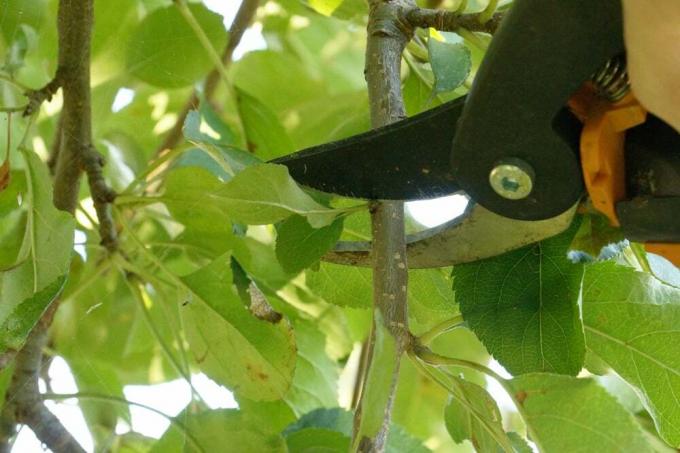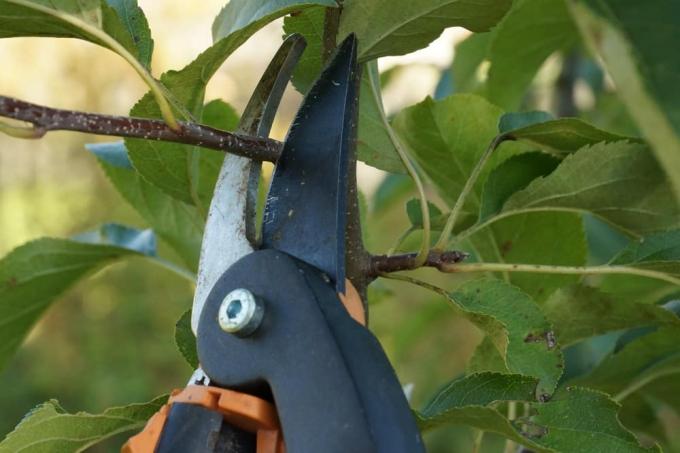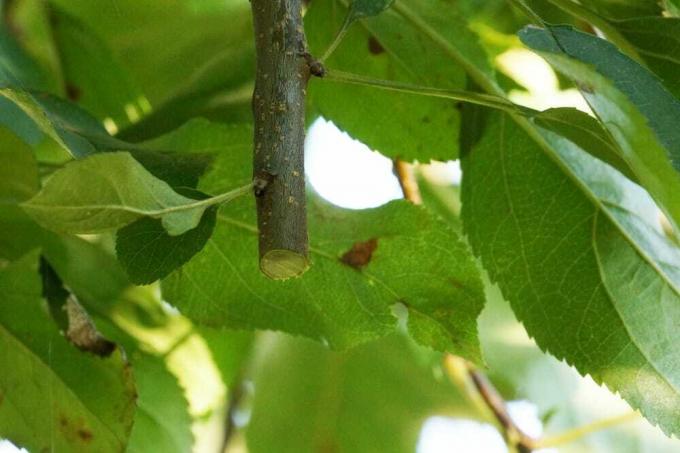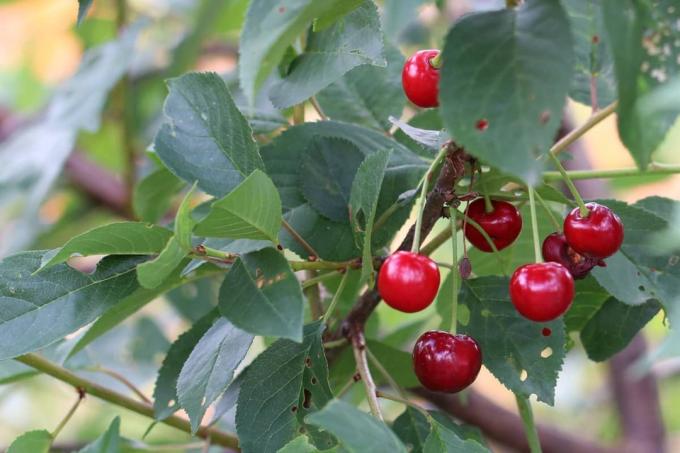

Table of contents
- The optimal time
- What is cut off in the fall?
- Autumn pruning of fruit trees
- Cut off water shoots
- remove competitive instincts
- Thin out
- Fall pruning of perennials and shrubs
- The necessary equipment
- tree saw
- anvil shears
- bypass scissors
- shrub shears
- Conclusion
For many plants, autumn heralds the coming hibernation. So that the plants survive the winter optimally and sprout vigorously in the following year, they should be prepared accordingly for the winter. The autumn cut supports the plants and at the same time creates the optimal conditions for lush growth. But be careful: Not all plants need or tolerate an autumn cut! In addition, under no circumstances should you cut indiscriminately, as this could seriously damage the plants.
The optimal time
The earliest possible time for the fall pruning is the 1st of September. October. Because the radical cutting off of the trees and hedges is, according to the Federal Nature Conservation Act of 1. March to 30. Banned September to protect nesting birds. It is therefore necessary to wait until October for the autumn pruning. It is best to cut back before the first frost. Because cutting off the branches and twigs creates wounds that should ideally heal and seal the plants from the frost. Temperatures that are too low not only impair wound healing, but could also cause the wood to splinter. This in turn allows pests to penetrate the plant more easily and thus represents an additional burden or risk. threat to them. In summary, the following conditions apply to the fall pruning date:
- from October on
- ideally before the first frost
- on a warm, sunny day
- the temperature should be above 0 degrees
- Shrubs and trees planted in the same year do not require fall pruning
What is cut off in the fall?
In general, when pruning in the fall, all excess branches and twigs are removed first. These are primarily old and dead branches and leaves. In addition to the dead wood, all diseased branches and parts of plants should always be removed, as these are considered a breeding ground for fungi and other pathogens. Depending on the plant, it may also be necessary to remove other branches and twigs. These include in particular those shoots that have no leaves or fruit. However, the general rule is that never too many branches and twigs should be removed. Because these serve as natural frost protection for the plant and sometimes offer animals a safe shelter in the cold winter months. In summary, the fall cut generally includes the following work steps:
- remove diseased and dead plant parts
- Cut off old and weak branches
- Eliminate excess side shoots
- too dense and cut off shoots that grow together
- Prune branches that have grown too long
Tip:
To reduce the risk of infection, it is advisable to always cut at an angle. Because this offers the least possible surface for bacteria to attack.
Autumn pruning of fruit trees

As soon as the tree has shed its leaves, it is the ideal time to cut it back. In principle, it is possible to cut the trees in autumn at temperatures below zero degrees carried out, however, the shoots could break or tear and the wood could become brittle become. It is therefore advisable to carry out the pruning on a sunny, frost-free day. When cutting back, make sure that the crown is as light as possible. As a result, the foliage dries faster after the rain, the air circulates better and the tree is less susceptible to fungal diseases. In addition to removing dead and diseased branches, fall pruning of fruit trees involves:
Cut off water shoots
The water shoots are also called water rippers or water shoots by hobby gardeners. These are summer shoots from old wood, which are usually located inside the tree crown. The water shoots arise from the so-called dormant buds, whose task is to restore lost branches or twigs. A particularly large number of water shoots can often be seen on trees if they were pruned too much in the previous year. Since the water shoots do not bear any buds and thus cost the tree unnecessary energy, they are regularly removed as follows:
- fresh water shoots can usually be torn off
- alternatively, the shoots are cut off
- it is best to cut it off directly on the knot
- so that the water shoots do not drive out again directly
remove competitive instincts
The competing shoots are branches that threaten to overgrow the tip of the central shoot. On the one hand, this results in a malformation of the tree crown and, on the other hand, the growth of the tree is impaired. Because the competitive instincts require a lot of energy, which the tree needs for growth and for the formation of fruit. In addition, the competing shoots prevent an optimal supply of light into the interior of the tree crown, which particularly affects the fruit. Because if these grow in the shade, they usually have a smaller shape and a sour taste. Therefore, it is essential to remove the competitive instincts as follows:
- first of all observe or redefine the framework of the tree
- usually there is a continuous central drive
- as well as three to four lateral guide branches
- these should all be at the same height (juice scale)
- Recognize and remove competitive instincts
- with thick branches, first cut from below and then from above
- then saw off the stump
Thin out
As a rule, the crown of the tree should be as light as possible, because this has several advantages. For one thing, more light reaches the interior of the tree crown, which means that the foliage dries faster after the rain. On the other hand, a crown that is as light as possible allows better air circulation, making the tree less susceptible to fungal diseases. In addition, the fruits also benefit from a light tree crown, because they receive more light, which in turn is noticeable in their shape and taste. Thinning out the crown is therefore an essential maintenance effort, during which the following parts of the plant are removed:
- branches growing inwards
- branches growing too steeply
- overlapping branches
- branches rubbing against each other
Fall pruning of perennials and shrubs

Whether the shrub needs an autumn cut depends primarily on the plant species. As a rule, evergreen species, such as the cherry laurel hedge, do not need a cut. These can be cut back, but the cut will not affect the intensity of flowering. There are also shrubs that absolutely do not tolerate autumn pruning, including laburnum, witch hazel and magnolia. The situation is different for the shrubs that bloom in summer, because they need to be cut back in autumn.
These include fruit bushes in particular, with blackberry and raspberry bushes in particular benefiting from this care measure. When pruning in the fall, all old and diseased branches and twigs are first removed. It is also important to cut off the old shoots to the ground. These can usually be recognized by their color, because the older a shoot is, the darker it is. In addition, the following plant parts should be removed when the shrubs are cut in autumn:
- shorten weak and sparse shoots
- Shorten the inward and criss-crossing branches
- cut them off close to the main shoot
- this allows the supply of light and air
- Also shorten shoots that are too close together
- Completely remove side shoots near the ground
Tip:
Since the strong shoots keep pushing to the top, they are only cut back a little. Thinner shoots, on the other hand, can easily be shortened considerably.
The necessary equipment
The use of special cutting tools not only simplifies the work for the hobby gardener, but also protects the plants. Because blunt tools can lead to injuries to the plants, which in turn increases the risk of infection. In addition, bacteria and pathogens can be transmitted by unclean tools. It is therefore essential to clean it before and after use and, if possible, to sterilize it. Plant sap and tree sap can easily be removed with a little oil, while dried-on residues can be removed with fine-grain sandpaper.
Once the tool is prepared for use, many hobby gardeners ask themselves which cutting tool to use. In particular, the type of plant and the amount of work to be taken into account. Because cutting back thick branches requires different equipment than cutting delicate branches of the shrubs. The following list of the necessary cutting tools provides the best overview:
tree saw
In order to cut the thick branches of trees, particularly robust tools such as a pruning saw are required. Folding saws and hacksaws in particular have proven themselves for cutting trees in the fall.
- for particularly thick branches
- the thicker the branch, the coarser the teeth of the saw
- the finer the teeth, the smoother the cut surface
- are also available with cable pull or telescopic rods
- This means that even particularly tall branches can be cut
anvil shears

The anvil shears have only one blade, which in turn hits a solid surface (called the anvil). Working with these scissors is extremely popular because comparatively little force is required. However, the disadvantage of these scissors is that the branches are not cut off, but "squeezed". This makes it easier for the bark to burst, which in turn increases the risk of injury to the plant.
- Removal of dead wood
- Cutting thicker branches
- Suitable for both trees and shrubs
bypass scissors
The bypass scissors, on the other hand, have a double-edged blade, which enables particularly clean and precise cuts. It is mostly used to cut thinner clippings such as shrubs or perennials.
- Cutting back green wood
- Cutting thin branches and twigs
- is not suitable for trees, but rather for shrubs
shrub shears
The use of shrub shears is particularly worthwhile for dense hedges and shrubs. These can also be used in a variety of ways, including cutting shrubs, bushes and box trees and shaping them artistically.
- Shaping and cutting shrubs
- Pruning of shrubs and hedges
- Cutting medium-thick branches and shoots (note the cutting thickness!)
Conclusion
Autumn pruning is an essential care measure for both shrubs and trees. Because the removal of excess, diseased and dead branches ensures that the plants have enough strength for the winter dormancy and sprout abundantly in the following year.
 garden editorial
garden editorial I write about everything that interests me in my garden.
Learn more about orchard care

Sour cherry - care instructions: Tips for the morello cherry
The sour cherry (Prunus cerasus) is ideal for smaller gardens because it grows small or shrub-like. Experts have a few tips to ensure that planting and harvesting works.

These 20 trees fertilize themselves | fruit trees
When cultivating fruit trees, pollination is an important aspect. Without them, fruit trees will not bear fruit, resulting in a failed harvest. Small gardens or balconies in particular are not suitable for several specimens. In this case, you should rely on self-pollinators.

Pruning a plum tree – instructions | When is the best time?
Pruning a plum tree is essential to ensure the highest possible yield for years to come and to keep the crop healthy. But when is the best time to do this and how should the blending be done? We tell.

Maintain espalier fruit trees | 5 tips on planting distance & care
Espalier fruit trees are an ornament for every garden and enliven unadorned walls and walls. It is true that creating it is very labor-intensive, but the effort is rewarded with a decorative appearance and sweet fruits. Certain factors must be taken into account when it comes to care and a sufficient planting distance.

Fruit tree diseases: recognizing common diseases
There is hardly a garden without fruit trees. They look splendid, give us shade and their fruits. Unfortunately, diseases sometimes spread. They can threaten the harvest and even the life of the tree. What are the clear signs?

The Best Fruit Tree Fertilizers - Basics of fruit tree fertilization
In order for fruit trees in the home garden to grow healthy and strong and to bear a variety of fruits, a balanced supply of nutrients must be guaranteed. In this article you will find out when, with what and how best to fertilize your fruit trees.



